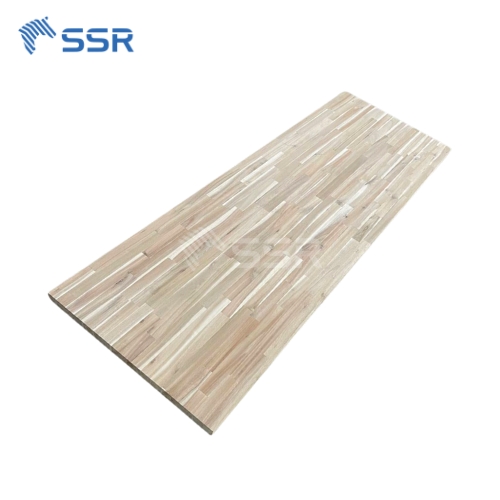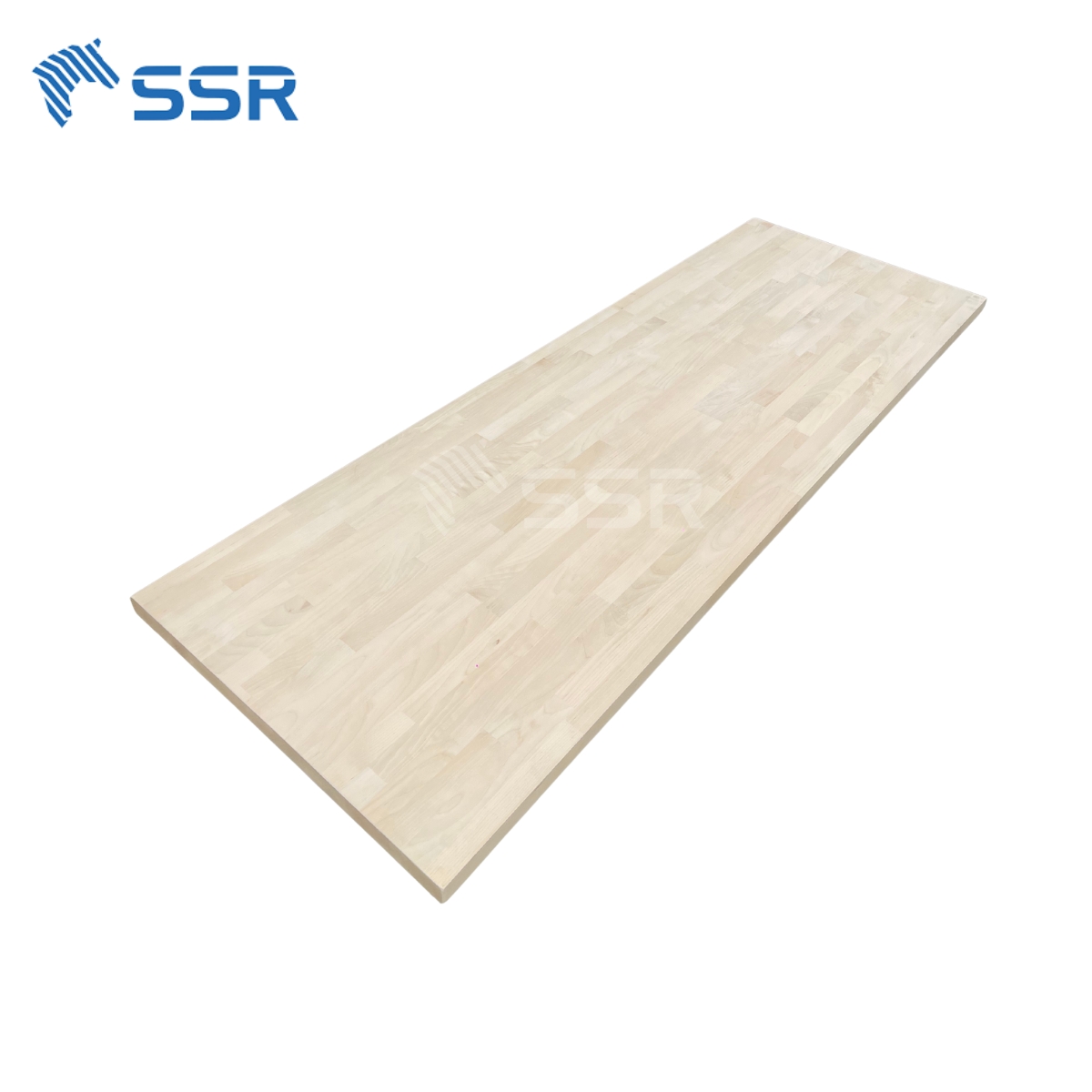NEWS
Looking to upgrade your kitchen essentials with a cutting board that’s both durable and beautiful? Acacia wood cutting boards are quickly becoming a top choice for home cooks and professionals alike. With their rich grain patterns, natural strength, and resistance to moisture, they offer a perfect blend of function and style. But not all boards are created equal.
In this guide, SSR VINA – trusted wooden chopping board will share smart buying tips to help you choose the right acacia wood cutting board for your needs whether you’re chopping vegetables, serving charcuterie, or gifting a premium kitchen piece.
What is Acacia Wood Cutting Board?
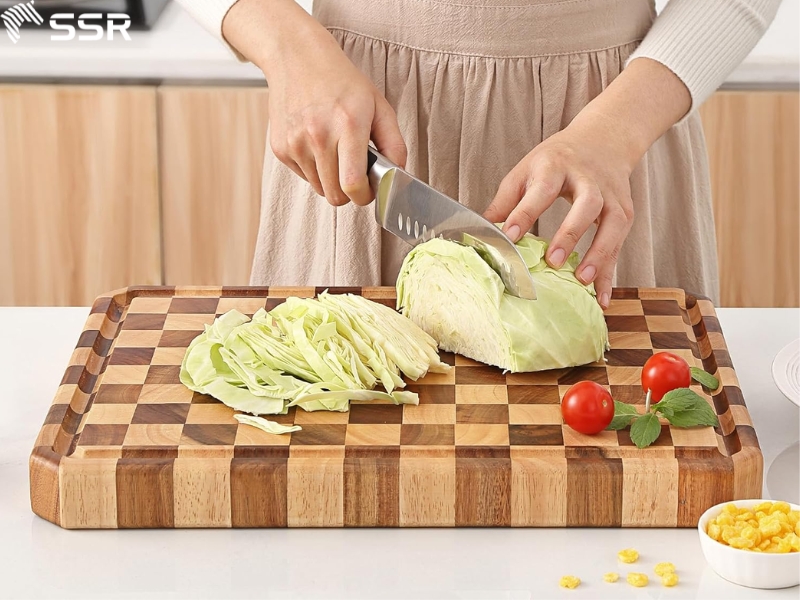
What is acacia wood cutting board
An acacia wood cutting board is crafted from the dense, durable hardwood of the Acacia tree – renowned for its rich grain patterns, natural luster, and exceptional strength. This tropical hardwood not only stands out for its visual appeal, but also for its ability to withstand heavy daily use in the kitchen.
The unique color tones of acacia wood, it ranging from warm golden hues to deep walnut shades make each cutting board a one-of-a-kind piece, often doubling as a functional tool and a serving or display tray.
Acacia Wood Cutting Board Pros and Cons
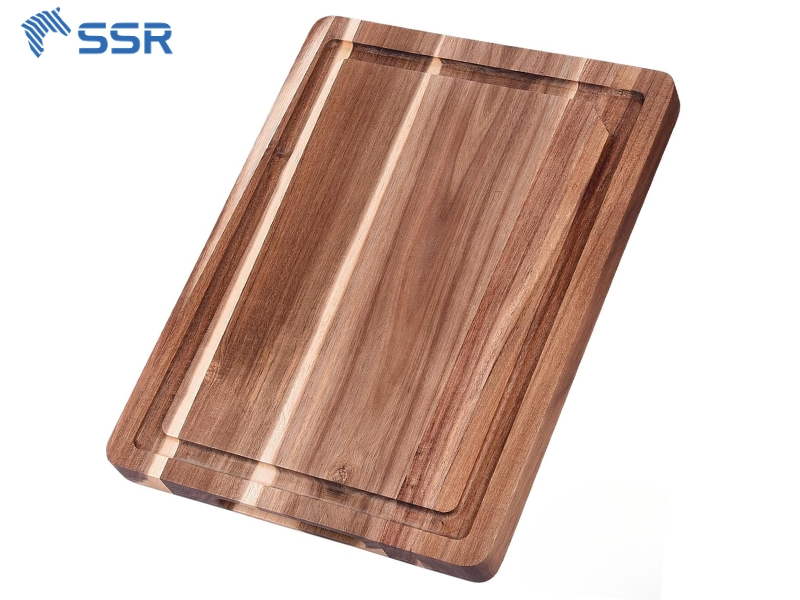
Pros and cons of acacia chopping board
Pros
- Durability: Hard and scratch-resistant surface.
- Water-Resistant: Naturally resists moisture and bacteria.
- Eco-Friendly: Sourced from fast-growing, renewable trees.
- Aesthetic Appeal: Rich, dark tones and natural grain patterns.
Cons
- Heavier Weight: May be bulkier than other wood types.
- Requires Maintenance: Needs regular oiling to prevent drying or cracking.
- Higher Price Point: Slightly more expensive than softwood alternatives.
Why Should You Care for Acacia Wood-Cutting Boards?
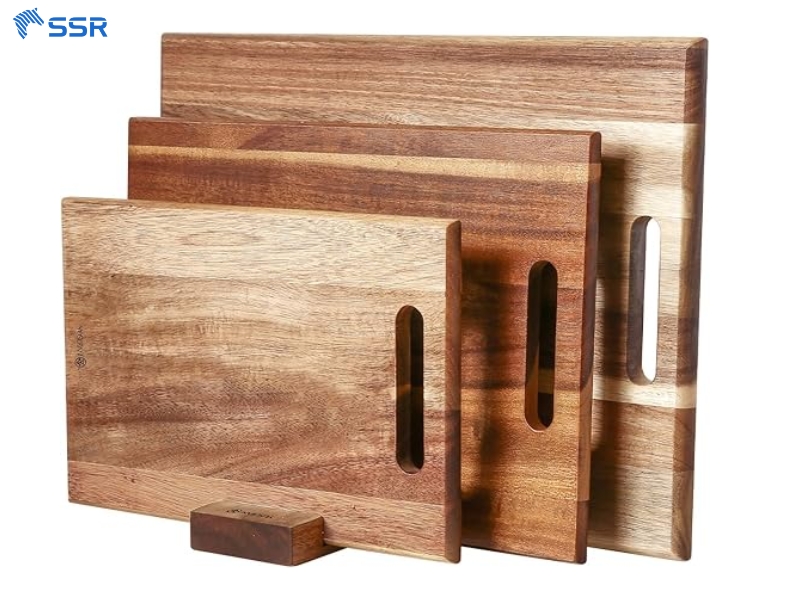
Why should you care for acacia wood-cutting boards
A well-maintained acacia board ensures better performance in the kitchen. A smooth, well-oiled surface is easier to clean, safer for food prep, and gentler on your knives. It also maintains its visual charm, making it suitable for serving foods directly at the table – be it cheeses, breads, or appetizers.
Caring for your board shows respect for the natural material it’s made from and extends its usability for years, if not decades. With just a bit of attention, your acacia cutting board can remain a dependable, attractive part of your kitchen for a long time.
- Preserves the board’s beauty and rich natural grain.
- Prevents cracking, warping, fading, and drying over time.
- Maintains a smooth, safe, and knife-friendly surface.
- Helps repel water, stains, and bacteria naturally.
- Enhances durability and extends lifespan for years of use.
- Keeps the board suitable for both prep and serving.
- Protects your investment with just minimal maintenance.
Caring for your acacia board ensures it remains both functional and beautiful ready for everyday cooking or stylish table presentation.
Ways to Maintain Acacia Chopping Board
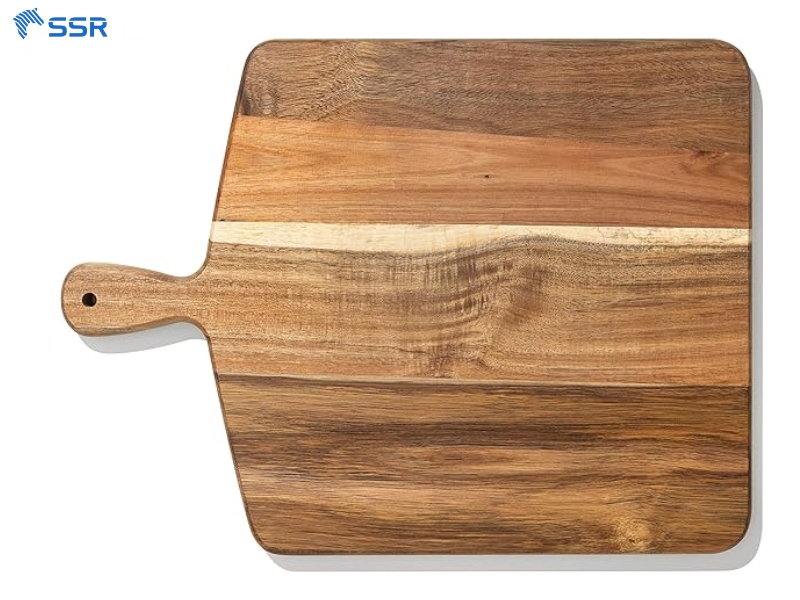
ways to maintain acacia chopping board
With years of experience manufacturing and exporting wooden cutting boards, we’ve learned that caring for your board is just as important as choosing the right one. Acacia is a durable, water-resistant hardwood but like all natural materials, it needs proper care to stay beautiful and functional. Here’s how to maintain it the right way.
How to Care for Acacia Wood Cutting Board?
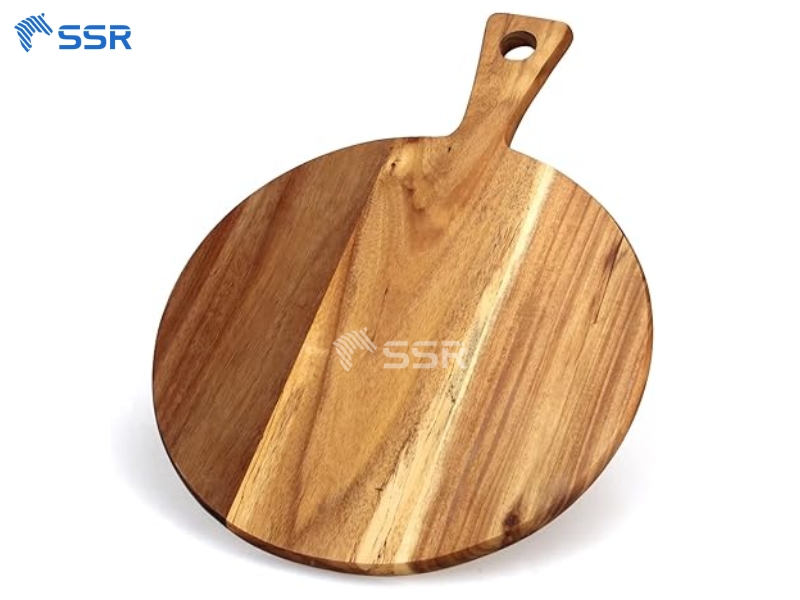
How to care for acacia wood cutting board
As a dense and durable hardwood, acacia is an excellent material for cutting boards but like any natural wood product, it requires proper care to maintain its beauty and functionality over time.
- Oil Regularly
Acacia tends to dry out if not conditioned. Apply food-safe mineral oil or beeswax once a month (or more frequently in dry climates) to keep the wood moisturized and prevent cracking. A well-oiled board also resists stains and odors more effectively. - Store Properly
Keep the board in a cool, dry place with good air circulation. Avoid storing it near heat sources or in damp environments, as extreme conditions can cause warping or splitting. - Avoid Excess Water Exposure
Never soak your acacia board or put it in the dishwasher. Excessive moisture can cause swelling, cracking, or mildew growth. Instead, wash it by hand with mild soap, rinse quickly, and dry immediately with a clean towel.
How to Wash Acacia Wood Cutting Board?
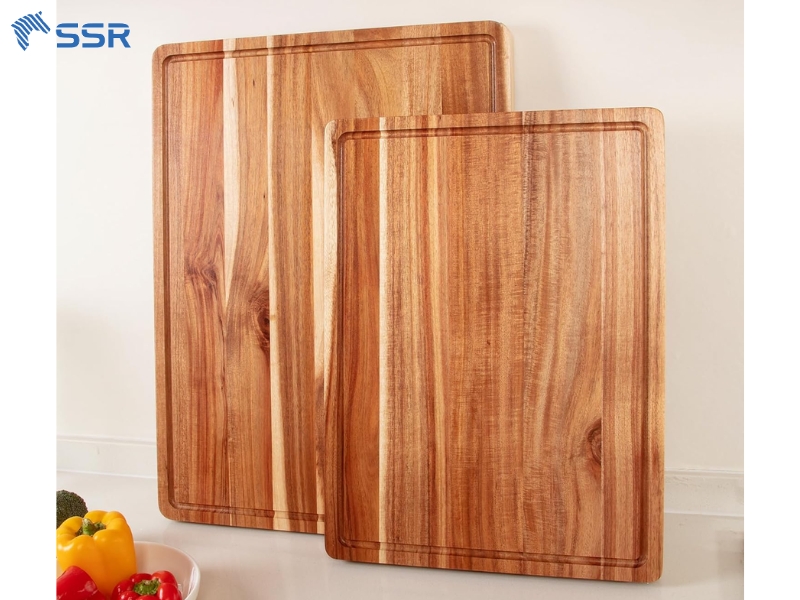
How to wash acacia wood cutting board
- Wash by hand: Use mild dish soap and warm water to gently clean the surface. Avoid soaking the board or using harsh detergents, as excessive water and chemicals can damage the wood.
- Scrub gently: If there are stubborn food residues, use a soft sponge or cloth to scrub the board carefully. Avoid abrasive scrubbers that can scratch the wood.
- Rinse thoroughly: Rinse the board well with warm water to remove all soap residues.
- Wipe dry immediately: Use a clean towel to dry the board right after washing. This helps prevent water from seeping into the wood, which could cause warping or cracking.
- Air-dry upright: Stand the board on its edge or lean it upright in a well-ventilated area to allow it to air-dry completely. This prevents moisture from being trapped underneath and reduces the risk of mold or mildew.
- Regular maintenance: To keep your acacia cutting board in top condition, periodically apply food-safe mineral oil or beeswax. This nourishes the wood, enhances its natural beauty, and creates a protective barrier against moisture.
- Avoid dishwasher and soaking: Never put your acacia wood board in the dishwasher or soak it in water. High heat and prolonged exposure to water can cause splitting and deterioration.
Best Oil for Acacia Wood Cutting Board
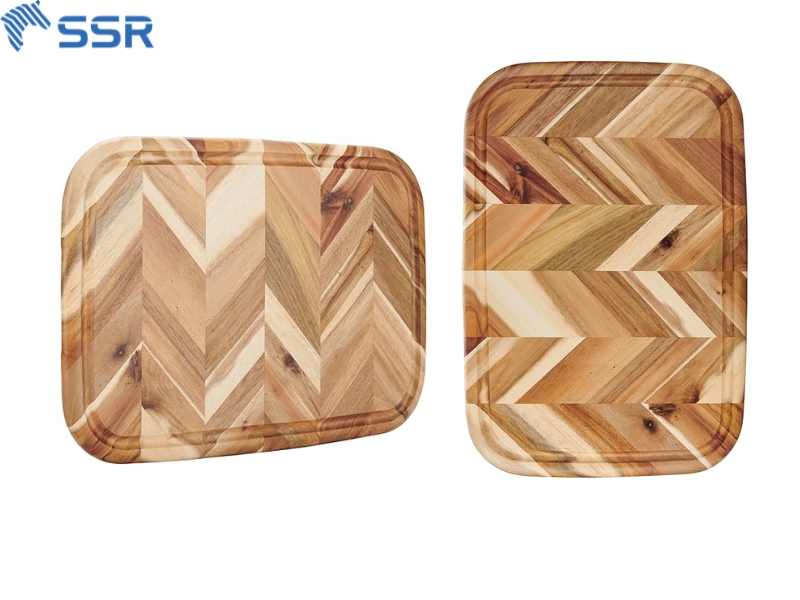
Best oil for acacia wood cutting board
- Mineral Oil:
Mineral oil is the most popular and widely recommended choice for conditioning acacia wood cutting boards. It is food-safe, colorless, odorless, and penetrates deeply into the wood fibers, helping to prevent drying, cracking, and warping. Mineral oil creates a protective barrier that repels water and food stains, extending the life of your board. - Beeswax Conditioner:
Often combined with mineral oil, beeswax adds a layer of protection that seals the surface while providing a beautiful, natural shine. Beeswax also hydrates the wood, making it less prone to scratches and dullness. Many commercial wood conditioners blend beeswax and mineral oil for maximum benefit. - Refined Coconut Oil:
Refined (odorless) coconut oil is a natural alternative to mineral oil. It penetrates the wood and offers moisture retention without leaving a strong scent or flavor. However, avoid unrefined coconut oil, as it may go rancid over time and impart unpleasant odors to your board. - Walnut Oil:
Walnut oil is a natural drying oil that is food-safe and commonly used for wood finishing. It soaks into the wood fibers well and hardens to form a durable finish. Be cautious if you have nut allergies, and always ensure the oil is 100% pure and food-grade. - Tung Oil (Pure and Food-Grade):
Pure tung oil is a drying oil that provides a hard, water-resistant finish. It is food-safe once fully cured and offers excellent protection against moisture and stains. Make sure to use 100% pure tung oil with no additives for safe use on cutting boards.
Tips for Application:
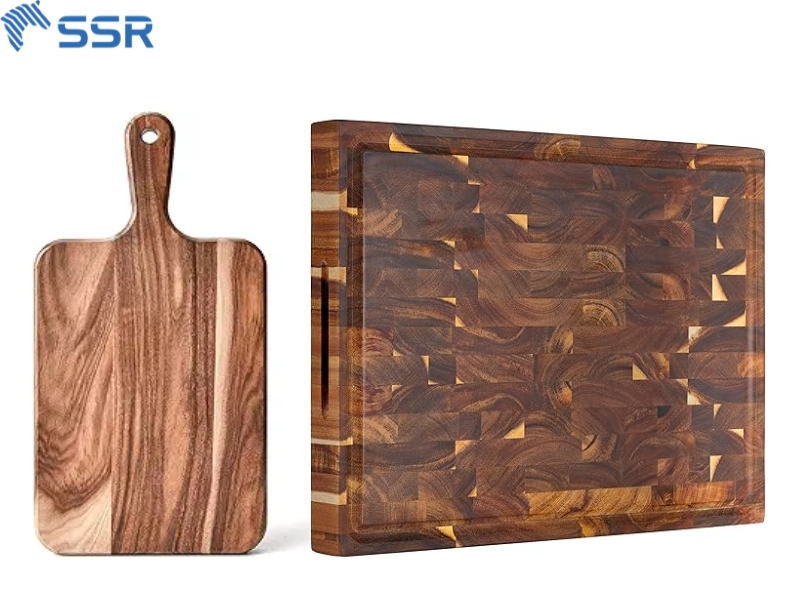
Acacia wood cutting board
- Apply oil generously with a clean, soft cloth or paper towel.
- Let the oil soak in for several hours or overnight.
- Wipe off excess oil to avoid a sticky surface.
- Repeat treatment regularly (every few weeks or after heavy use) to keep the board well-conditioned.
Acacia Wood Chopping Board vs Other Chopping Boards
Acacia Wood vs Bamboo Cutting Board
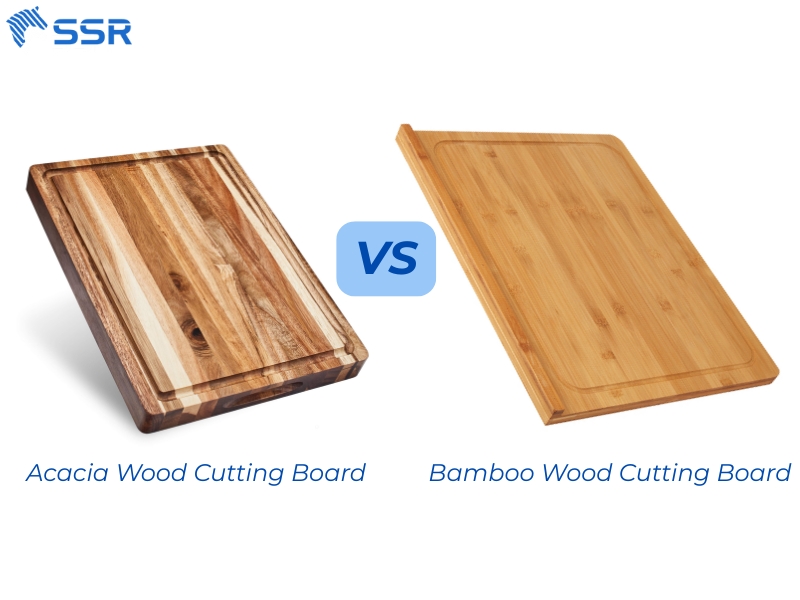
Acacia wood vs bamboo cutting board
| Criteria | Acacia Wood Cutting Board | Bamboo Cutting Board |
| Hardness & Durability | Medium to high hardness, very durable, impact-resistant | Very hard and durable, but can crack if not maintained properly |
| Effect on Knives | Softer on knives, less likely to dull blades | Harder surface can dull knives faster |
| Weight | Heavier, feels solid and sturdy | Lightweight, easy to handle and move |
| Appearance | Rich, dark brown color with beautiful wood grain, elegant look | Light color with distinctive striped pattern, modern aesthetic |
| Water Resistance | Good resistance if regularly oiled and maintained | Quite water-resistant due to dense structure |
| Eco-friendliness | Sustainable, from fast-growing trees that can be replanted | Very eco-friendly, bamboo grows extremely fast and regenerates easily |
| Maintenance | Requires regular oiling to prevent drying and cracking | Needs consistent oiling; avoid prolonged soaking |
| Cost | Generally more expensive due to durability and aesthetics | Usually more affordable and widely available |
| Natural Antibacterial Properties | Good natural resistance to bacteria due to wood oils | Naturally antibacterial due to tight fiber structure |
Acacia Wood vs Teak Cutting Board

Acacia wood vs teak cutting board
| Criteria | Acacia Wood Cutting Board | Teak Wood Cutting Board |
| Hardness & Durability | Slightly harder than teak, very durable | Durable but a bit softer than acacia |
| Surface Texture | Smooth but less oily surface | Naturally oily surface, which repels water and stains |
| Maintenance | Requires regular oiling to prevent drying/cracking | Low maintenance due to natural oils, less frequent oiling needed |
| Water Resistance | Good if properly oiled and cared for | Excellent water resistance thanks to natural oils |
| Price | More affordable, great value for durability | Pricier due to its natural oils and premium quality |
| Appearance | Rich brown with varied grain patterns | Golden brown with tight, straight grain; very attractive |
| Effect on Knives | Gentle on knives, doesn’t dull blades quickly | Slightly harder, but still knife-friendly |
| Weight | Medium weight, sturdy | Typically heavier, solid feel |
| Eco-Friendliness | Sustainable, from fast-growing plantations | Sustainable if sourced responsibly, slower growth than acacia |
| Natural Antibacterial Properties | Good natural resistance due to dense grain and oils | Excellent antibacterial properties from natural teak oils |
Acacia Wood vs RubberWood Cutting Board
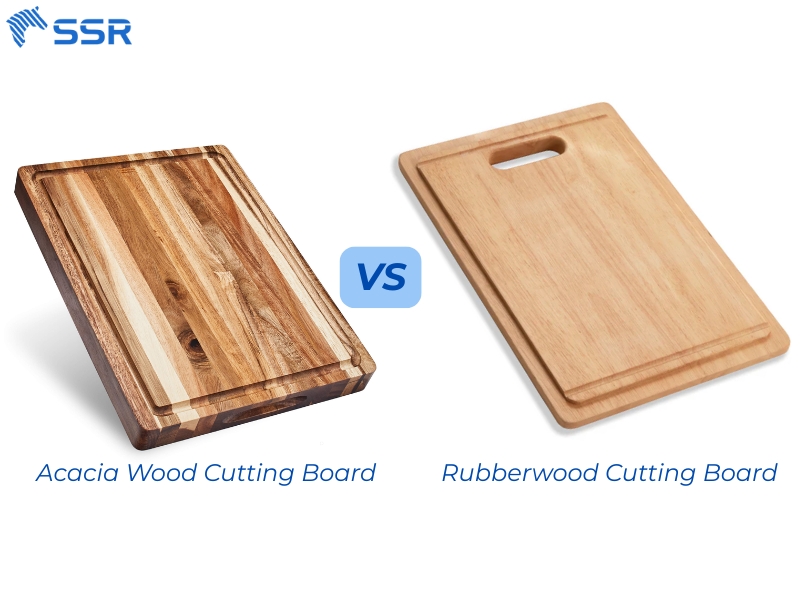
Acacia wood vs rubberwood cutting board
| Criteria | Acacia Wood Cutting Board | Rubberwood Cutting Board |
| Grain & Texture | Stronger, tighter grain with rich texture | Softer, more porous grain, less pronounced texture |
| Durability | More durable and resistant to wear and tear | Less durable, more prone to dents and scratches |
| Water Resistance | More water-resistant due to dense grain and natural oils | Less water-resistant, requires careful maintenance to avoid swelling or warping |
| Price | Generally more expensive | More affordable and widely available |
| Weight | Heavier and sturdier | Lighter but less robust |
| Effect on Knives | Gentle on knives, helps preserve sharpness | Fairly gentle but may dull knives faster than acacia |
| Appearance | Rich brown tones with varied natural patterns | Light yellow to pale brown, more uniform look |
| Eco-Friendliness | Sustainable, from fast-growing trees | Highly sustainable as it is a byproduct of rubber plantations |
| Maintenance | Requires regular oiling to maintain water resistance and appearance | Needs frequent oiling and careful drying to prevent damage |
| Natural Antibacterial Properties | Moderate natural resistance | Moderate, but less oily, so may absorb bacteria more easily |
Types of Acacia Wood Cutting Boards
1. Acacia Wood Round Cutting Board
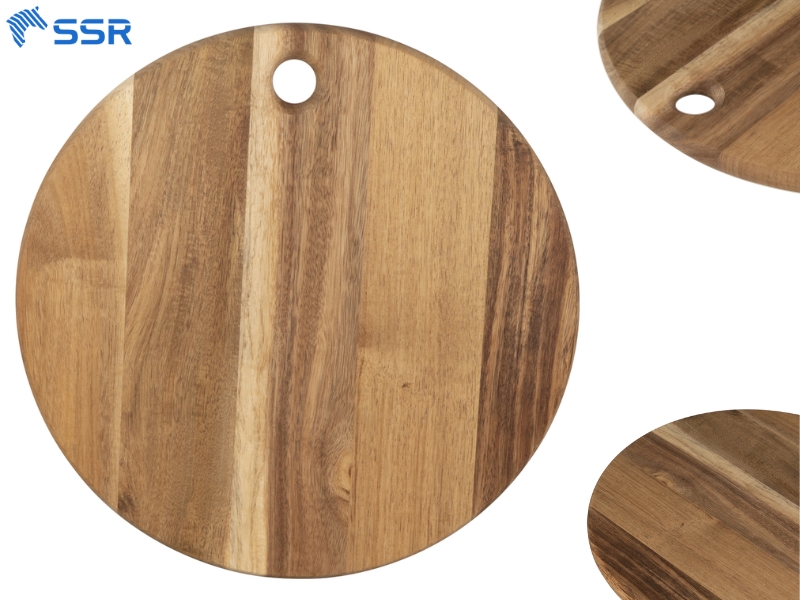
Acacia wood round cutting board
Perfect for serving cheeses, pizzas, fruits, or small chopping tasks. Its round shape adds a rustic charm and doubles as a stylish serving tray for casual gatherings or elegant table settings.
-
Acacia Wood Cutting Board with Handle
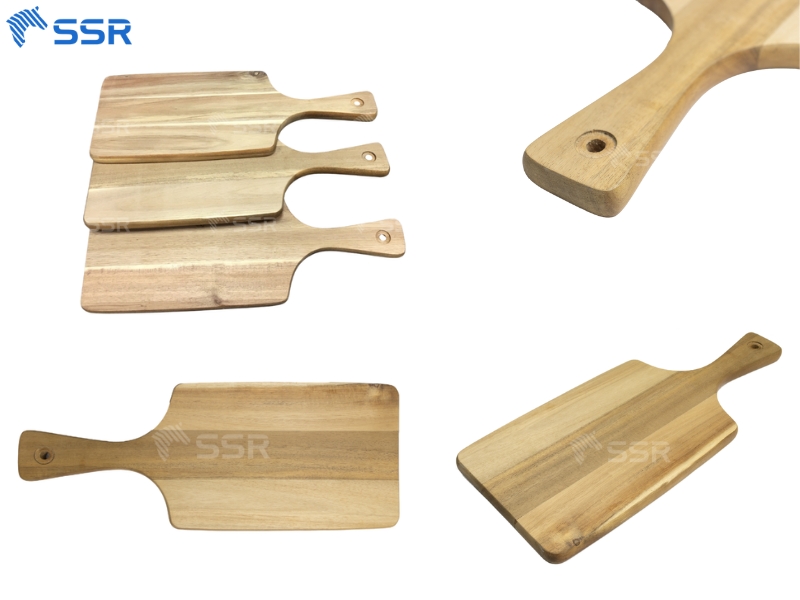
Acacia wood cutting board with handle
Designed with an ergonomic handle for easy gripping, hanging, or carrying from kitchen to table. Ideal for prepping ingredients or serving bread, snacks, and charcuterie with convenience and style.
-
Acacia Wood Rectangular Cutting Board
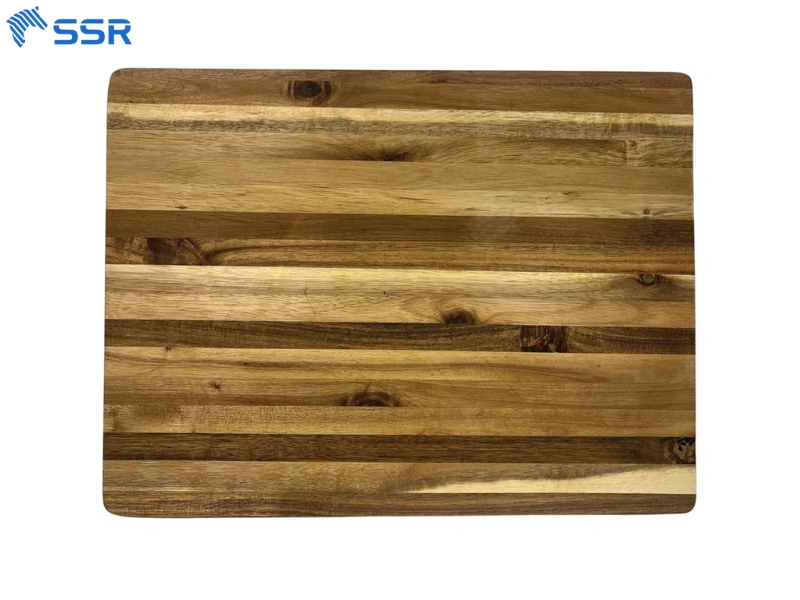
Acacia wood rectangular cutting board
A classic, all-purpose cutting board offering a generous surface area. Great for everyday use like: chopping vegetables, slicing meats, or preparing meals in bulk. Its solid build ensures long-lasting durability.
-
Acacia Wood Paddle Board
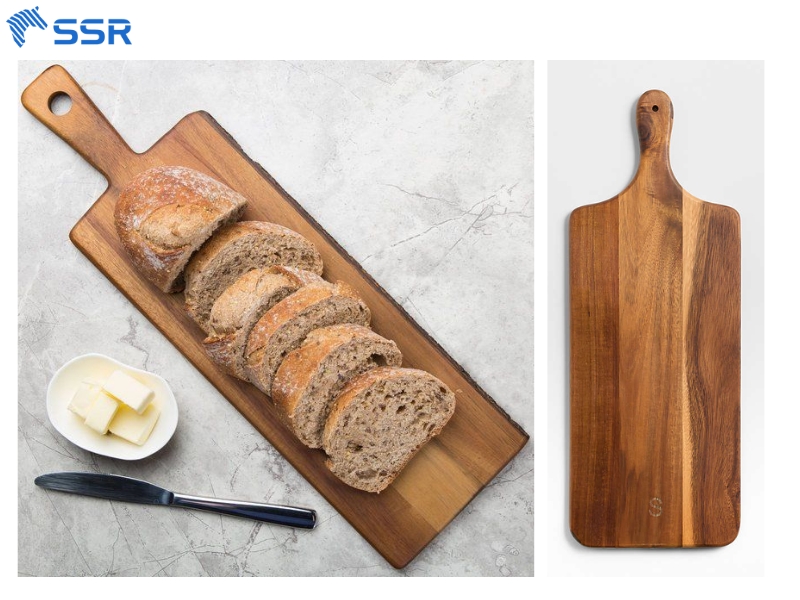
Acacia wood paddle board
With its elongated paddle shape, this board is perfect for serving appetizers, flatbreads, or tapas. The slim profile makes it easy to store or hang, while still being sturdy for light chopping needs.
-
Acacia Wood Juice Groove Cutting Board
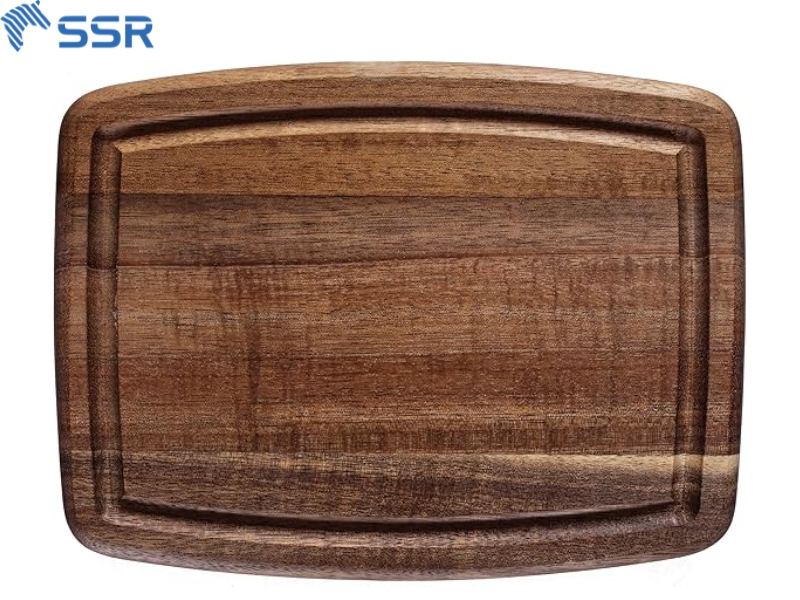
Acacia wood juice groove cutting board
Engineered with a built-in groove around the edge to catch juices from fruits, meats, or vegetables keeping your countertop clean. Ideal for carving and meal prep with minimal mess.
-
Acacia Wood End Grain Cutting Board
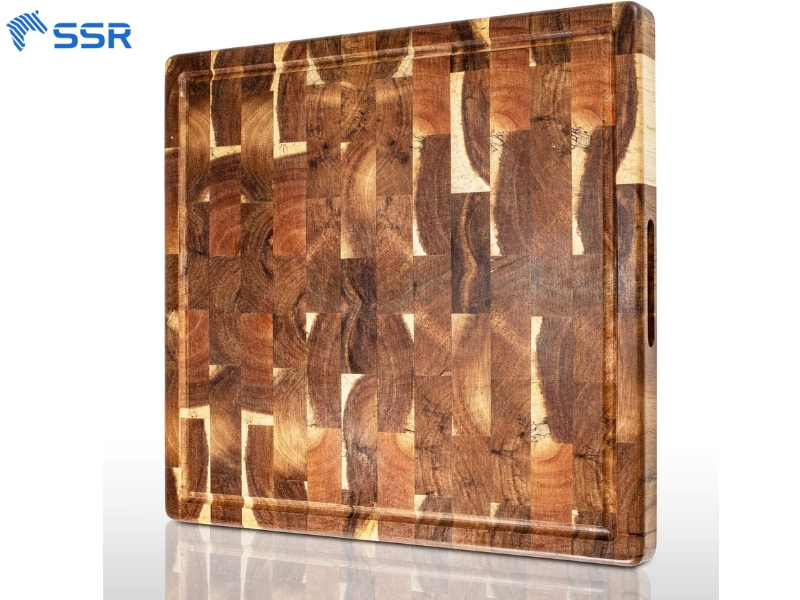
Acacia wood end grain cutting board
Constructed with the end grain of the wood, this board is not only visually striking but also highly durable and gentle on knives. Built to withstand heavy chopping while resisting deep cuts.
-
Acacia Wood Reversible Cutting Board
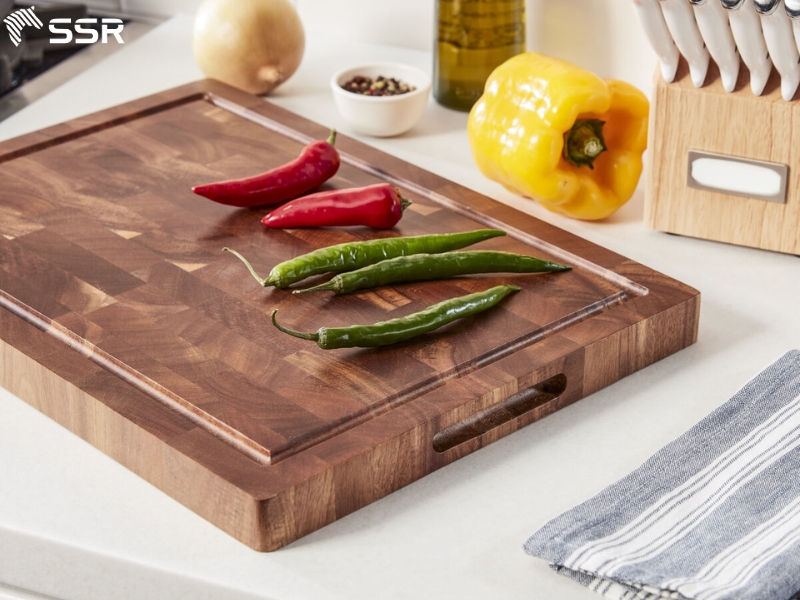
Acacia wood reversible cutting board
Offers two usable surfaces with one side for chopping, the other for serving. Practical and multifunctional, it reduces cross-contamination and maximizes prep space in compact kitchens.
-
Acacia Wood Serving & Cheese Board Set
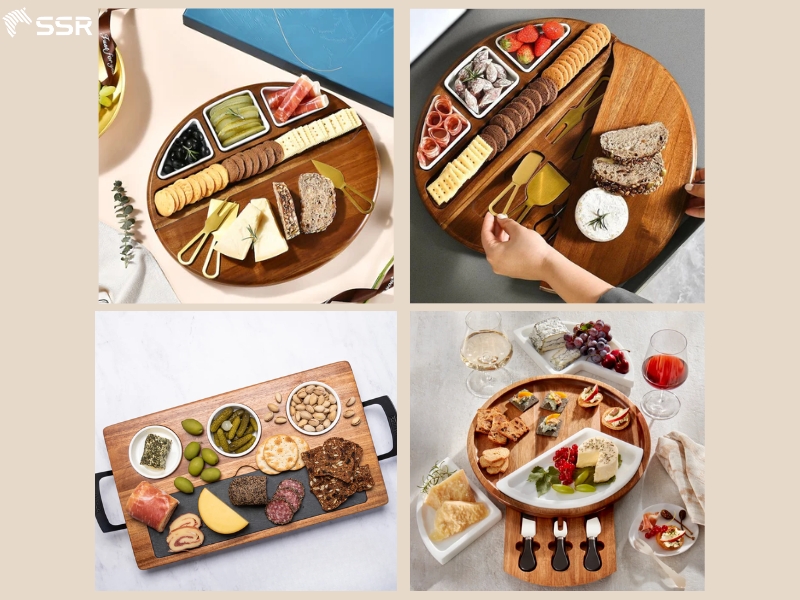
Acacia wood serving and cheese board set
Tailored for entertaining, this set often includes utensils, slots for crackers, or small bowls. The luxurious acacia grain elevates the presentation of cheeses, fruits, or desserts.
SSR VINA – Your Trusted Acacia Wood Supplier
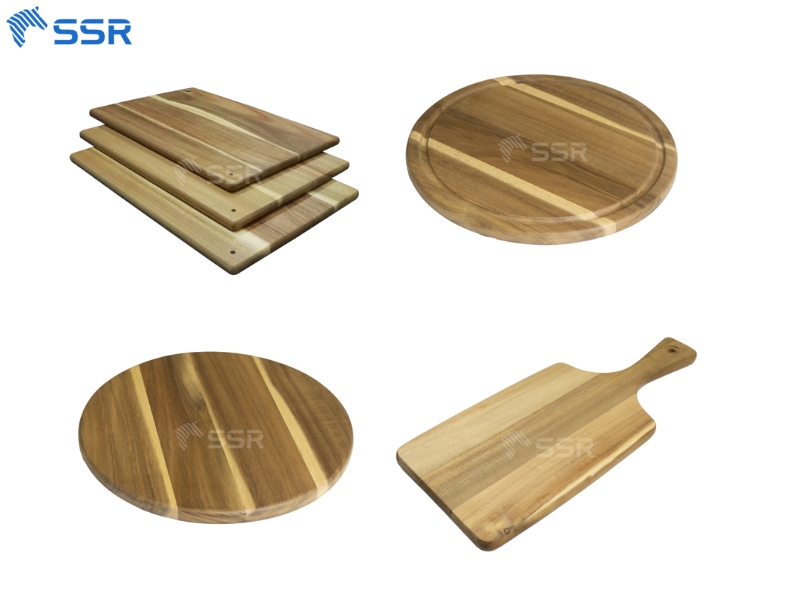
SSR VINA your trusted acacia wood supplier
If you’re looking for a high-quality, durable, and eco-friendly acacia cutting board, SSR VINA is the ideal place to buy. As a leading manufacturer and exporter of solid wood products in Vietnam, SSR VINA specializes in producing acacia chopping boards made from sustainably sourced acacia, teak and rubber wood.
Each acacia board is crafted through a strictly controlled process from raw material selection to final oil finishing ensuring food safety, longevity, and beautiful natural wood grain. With FSC-certified wood, customizable designs, and bulk export capabilities, SSR VINA is a trusted supplier for both household users and global retailers. Choosing SSR VINA means choosing craftsmanship, quality, and sustainability.
FAQs
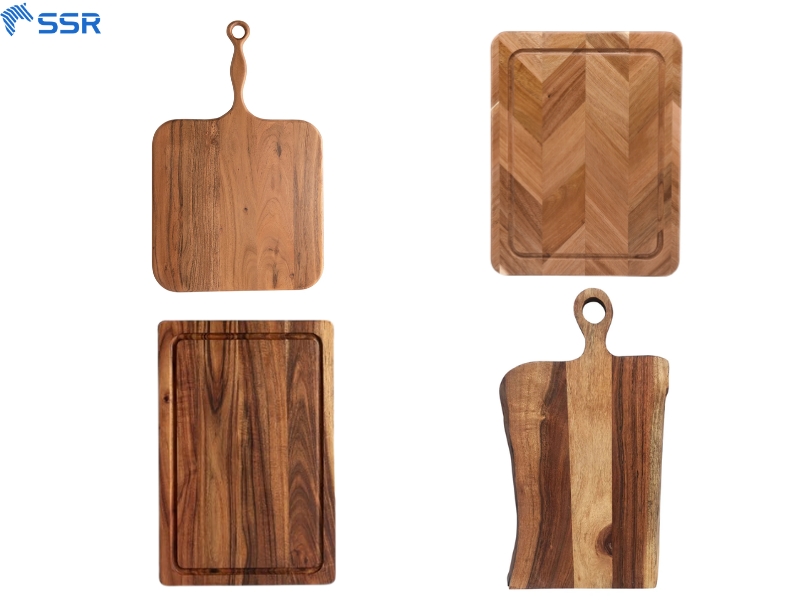
Acacia wood cutting board supplier
Is Acacia Wood Good for Cutting Boards?
Yes! Acacia wood is excellent for cutting boards thanks to its hardness, resistance to water, and antibacterial properties.
Do You Need to Oil an Acacia Wood Cutting Board?
Yes, regular oiling prevents the wood from drying and cracking.
Can You Cut Meat on an Acacia Wood Cutting Board?
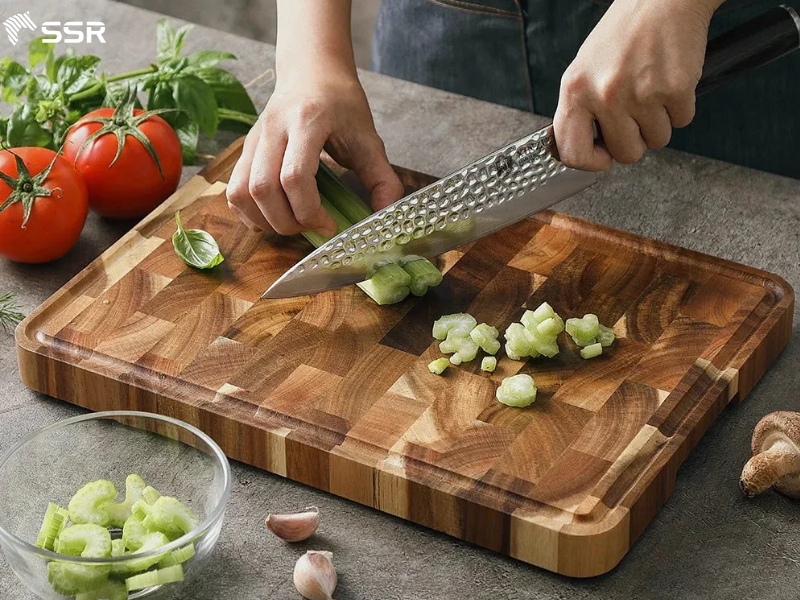
Is Acacia Wood Good for Cutting Boards
Absolutely. Just ensure thorough cleaning afterward to avoid cross-contamination.
Are Acacia Cutting Boards Antimicrobial?
are acacia cutting boards antimicrobial
Acacia has natural antibacterial properties, making it safer for food prep.
Why Are Acacia Cutting Boards So Cheap?
Despite being a hardwood, acacia is abundant and fast-growing, making it cost-effective.
Conclusion
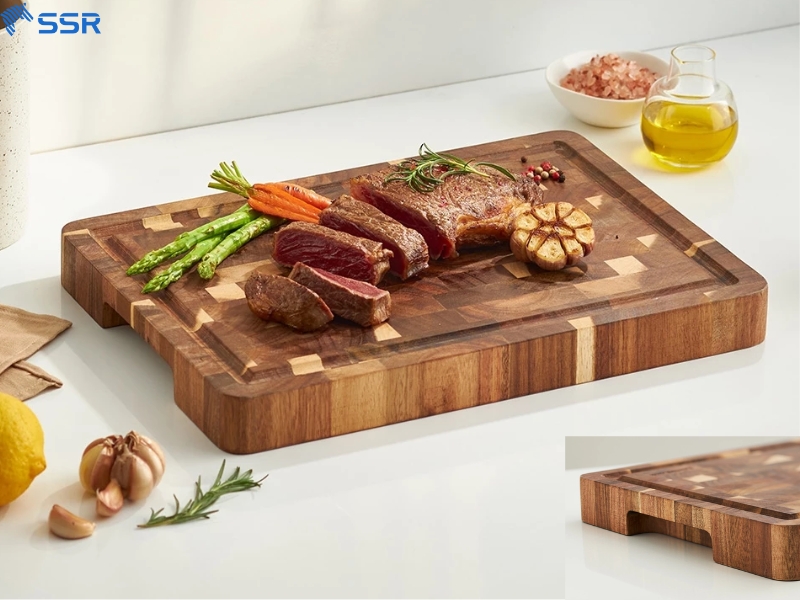
Premium acacia wood chopping boards
Choosing the right cutting board is about more than just kitchen aesthetics – it’s about investing in quality, durability, and functionality.
At SSR VINA, we take pride in delivering premium acacia wood chopping boards that meet the highest standards of craftsmanship and food safety.
Smart design, sustainable sourcing, and expert finishing – that’s what makes SSR VINA your trusted partner in wooden kitchenware. Let your kitchen benefit from the natural strength and timeless appeal of acacia wood, crafted with care and delivered with confidence.
READ MORE: Wood Cutting Board Supplier Tips: What Buyers Need to Know
Featured Products
Acacia Wood Butcher Block Countertops Supplier
Specifications:
- Species: Acacia
- Moisture: < 12%
- Wood Stave (Length): 150-400 mm
- Wood Stave (Width): 30-80 mm
- Length & Width tolerance: 0/+3 mm
- Thickness tolerance: +/- 0.2 mm
- Glue: D4
- Quality: AB, BC or customized
- Surface finish: Sanding 180-240 grit, 2 faces
Rubberwood Finger Joint Board Supplier
- Species: Rubberwood
- Moisture: <12 %
- Wood Stave (Length): 150-600 mm
- Wood Stave (Width): 35-80 mm
- Length & Width tolerance: 0/+3 mm
- Thickness tolerance: +/- 0.2 mm
- Glue: D4
- Quality: AA, AC or customized
- Surface Finish: sanding 240-320 grit, 2 faces
Birch Butcher Block Countertop Supplier
Specifications:
- Species: Birch
- Moisture: < 12%
- Wood Stave (Length): 150-400 mm
- Wood Stave (Width): 20-80 mm
- Length & Width tolerance: 0/+3 mm
- Thickness tolerance: +/- 0.2 mm
- Glue: D4
- Quality: AB, AC or customized
- Surface finish: Sanding 180-240 grit, 2 faces.
Featured News
Related News
SSR Wood in Tay Ninh: Groundbreaking a New Production Hub
SSR held the groundbreaking ceremony for its new wood processing facility in Tay Ninh on November 28. The plant covers 21,300 square meters, is designed to produce 2,000 cubic meters per month, and is expected to employ around 400 workers once fully operational. The project represents a significant expansion of SSR’s manufacturing capacity in Southern […]

SSR VINA becomes VCCI Member: A New Milestone
SSR VINA is proud to announce its official VCCI member (Vietnam Chamber of Commerce and Industry) – the nation’s leading organization representing the business community and employers in Vietnam. This marks a significant milestone in SSR VINA’s journey to enhance the global presence of “Made-in-Vietnam” products, reaffirming our commitment to quality, innovation, and sustainable growth. […]

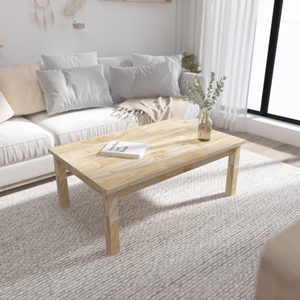
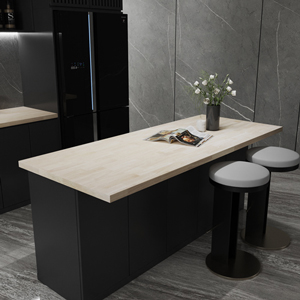
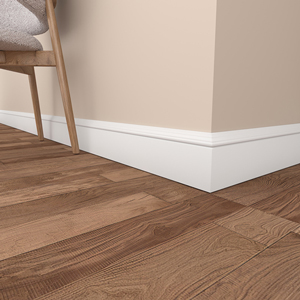
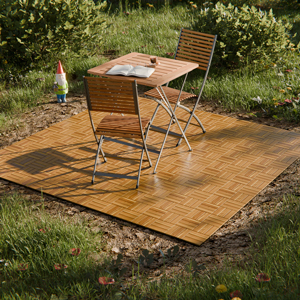
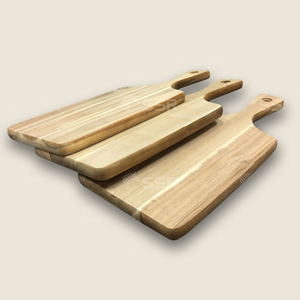
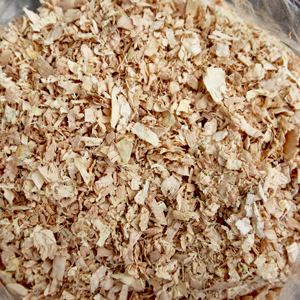

 Tháng 5 25, 2025
Tháng 5 25, 2025 | SSR
| SSR